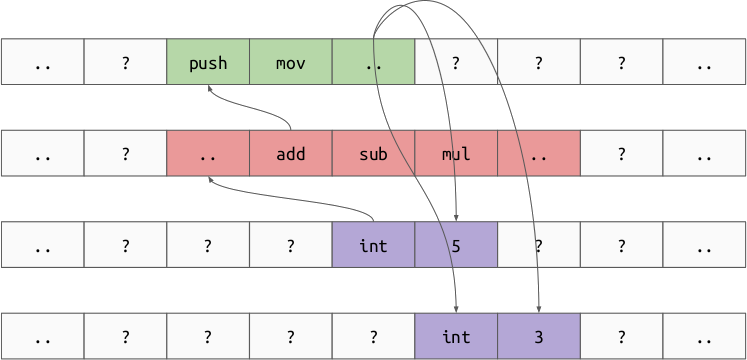Python Overview¶
Note
Some of this content is specific to CPython, which is most common
implementation of Python. This is the program that runs when you run $
python in a terminal.
Python is a high level programming language, meaning that it is designed to abstract away the details of the machine, and instead present a simpler interface. The Python programming language provides a few important features that make programming easier:
- Automatic Memory Management.
- Object oriented programming.
- Dynamic typing.
Python Objects¶
In object oriented programming (OOP), objects are values paired
with their operations. For example, to execute the code a + b, we need to
inspect a at runtime and ask a how a it performs addition.
To store the behavior, Python has objects need to carry around a collection of implementations for all of the operations they support in a way that may be accessed dynamically. One way to do this, given a fixed set of operations which may be performed, would be to use a struct to store the addresses of the operations at fixed offsets from some base address. For example:
struct type {
pointer add_address;
pointer sub_address;
pointer mul_address;
pointer div_address;
...
};
Then, values can be a struct like:
struct value {
pointer type;
// type specific data goes here
};
Because the size of each value differs depending on the type, which cannot be
known ahead of time because Python is dynamically typed, Python just refers to
all objects through a pointer to the value struct. All we know is that the
first member of the value struct will be a pointer to some collection of
functions which will be designed to know the true size of the object and how to
interpret the data. This means that at minimum we must do one memory
dereference to perform any operation on a Python object.
Using this model, let’s walk through the execution of:
a + b
- Dereference
a. - Dereference
a’s type. - Jump to the implementation of
addfor the type of a. - Dereference
b - Check if the type of
bcan be added to the type ofa. - If not, throw an exception. - Allocate memory to store the result of the addition.
- Perform the addition and store the result in the newly allocated memory.
Here is what all of the memory dereferences look like for
5 + 3.

Overhead¶
All of this extra “pointer chasing”, runtime type checking, and allocation really adds up. For example, let’s inspect a simple dot product function:
def dot(xs, ys):
out = 0
ix = 0
while ix < len(xs):
x = xs[ix]
y = ys[ix]
out += x * y
ix += 1
return out
Let’s see how this function performs:
In [2]: xs = [1, 2, 3]
In [3]: ys = [4, 5, 6]
In [4]: dot(xs, ys)
Out[4]: 32
In [5]: 1 * 4 + 2 * 5 + 3 * 6
Out[5]: 32
In [7]: xs = [random.random() for _ in range(10000)]
In [8]: ys = [random.random() for _ in range(10000)]
In [9]: dot(xs, ys)
Out[9]: 2493.0449981169236
In [10]: %timeit dot(xs, ys)
1.52 ms ± 15.4 µs per loop (mean ± std. dev. of 7 runs, 1000 loops each)
1.5 milliseconds to take the dot product of 10000 elements, that seems pretty
quick, but what about a more pythonic implementation of dot?
def pythonic_dot(xs, ys):
return sum(x * y for x, y in zip(xs, ys))
In [12]: %timeit pythonic_dot(xs, ys)
552 µs ± 8.65 µs per loop (mean ± std. dev. of 7 runs, 1000 loops each)
This function is shorter and better expresses our intent. It is also
considerably faster, why is that? In short, Python’s built in function like
zip and sum take advantage of the repetition of accessing
elements. Instead of constantly checking the object and saying, “how should I
retrieve elements from you”, it asks the question once and re-uses the answer
many times. This reduces the over all number of memory accesses and instructions
needed.